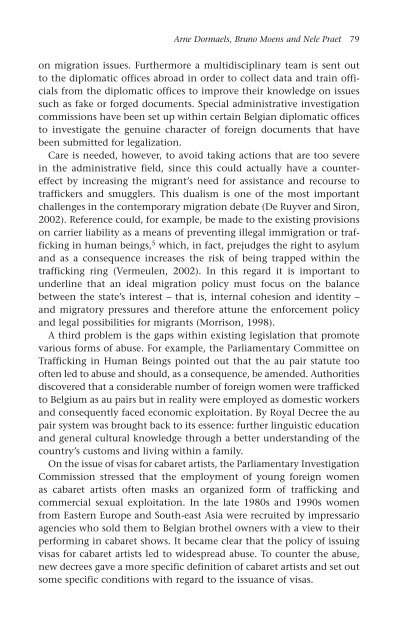3071-The political economy of new slavery
3071-The political economy of new slavery
3071-The political economy of new slavery
You also want an ePaper? Increase the reach of your titles
YUMPU automatically turns print PDFs into web optimized ePapers that Google loves.
Arne Dormaels, Bruno Moens and Nele Praet 79<br />
on migration issues. Furthermore a multidisciplinary team is sent out<br />
to the diplomatic <strong>of</strong>fices abroad in order to collect data and train <strong>of</strong>ficials<br />
from the diplomatic <strong>of</strong>fices to improve their knowledge on issues<br />
such as fake or forged documents. Special administrative investigation<br />
commissions have been set up within certain Belgian diplomatic <strong>of</strong>fices<br />
to investigate the genuine character <strong>of</strong> foreign documents that have<br />
been submitted for legalization.<br />
Care is needed, however, to avoid taking actions that are too severe<br />
in the administrative field, since this could actually have a countereffect<br />
by increasing the migrant’s need for assistance and recourse to<br />
traffickers and smugglers. This dualism is one <strong>of</strong> the most important<br />
challenges in the contemporary migration debate (De Ruyver and Siron,<br />
2002). Reference could, for example, be made to the existing provisions<br />
on carrier liability as a means <strong>of</strong> preventing illegal immigration or trafficking<br />
in human beings, 5 which, in fact, prejudges the right to asylum<br />
and as a consequence increases the risk <strong>of</strong> being trapped within the<br />
trafficking ring (Vermeulen, 2002). In this regard it is important to<br />
underline that an ideal migration policy must focus on the balance<br />
between the state’s interest – that is, internal cohesion and identity –<br />
and migratory pressures and therefore attune the enforcement policy<br />
and legal possibilities for migrants (Morrison, 1998).<br />
A third problem is the gaps within existing legislation that promote<br />
various forms <strong>of</strong> abuse. For example, the Parliamentary Committee on<br />
Trafficking in Human Beings pointed out that the au pair statute too<br />
<strong>of</strong>ten led to abuse and should, as a consequence, be amended. Authorities<br />
discovered that a considerable number <strong>of</strong> foreign women were trafficked<br />
to Belgium as au pairs but in reality were employed as domestic workers<br />
and consequently faced economic exploitation. By Royal Decree the au<br />
pair system was brought back to its essence: further linguistic education<br />
and general cultural knowledge through a better understanding <strong>of</strong> the<br />
country’s customs and living within a family.<br />
On the issue <strong>of</strong> visas for cabaret artists, the Parliamentary Investigation<br />
Commission stressed that the employment <strong>of</strong> young foreign women<br />
as cabaret artists <strong>of</strong>ten masks an organized form <strong>of</strong> trafficking and<br />
commercial sexual exploitation. In the late 1980s and 1990s women<br />
from Eastern Europe and South-east Asia were recruited by impressario<br />
agencies who sold them to Belgian brothel owners with a view to their<br />
performing in cabaret shows. It became clear that the policy <strong>of</strong> issuing<br />
visas for cabaret artists led to widespread abuse. To counter the abuse,<br />
<strong>new</strong> decrees gave a more specific definition <strong>of</strong> cabaret artists and set out<br />
some specific conditions with regard to the issuance <strong>of</strong> visas.


